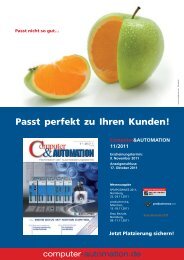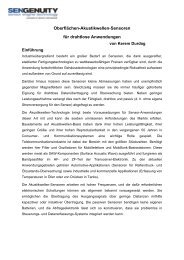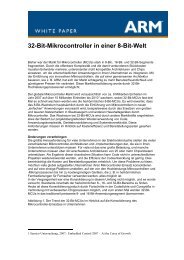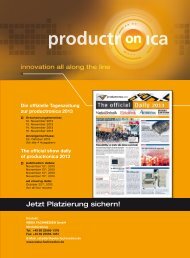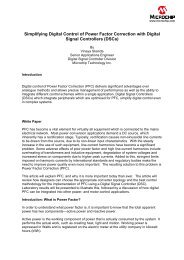PWM and PFM Operation of DC/DC Converters ... - next!-Community
PWM and PFM Operation of DC/DC Converters ... - next!-Community
PWM and PFM Operation of DC/DC Converters ... - next!-Community
You also want an ePaper? Increase the reach of your titles
YUMPU automatically turns print PDFs into web optimized ePapers that Google loves.
Topic 7<br />
signal used is constant in frequency but varies in<br />
its duty cycle (ratio <strong>of</strong> power-FET on time to the<br />
total switching period). The clock frequency is<br />
fixed <strong>and</strong> the pulse width <strong>of</strong> each clock cycle is<br />
adjusted based on operating conditions. Hence,<br />
this approach is referred to as “pulse-width<br />
modulation,” or “<strong>PWM</strong>.”<br />
B. <strong>PFM</strong> Converter<br />
A <strong>PFM</strong> converter is an alternative <strong>DC</strong>/<strong>DC</strong><br />
power-converter architecture that uses a variablefrequency<br />
clock to drive the power switches <strong>and</strong><br />
transfer energy from the input to the output.<br />
Because the drive signal’s frequency is directly<br />
controlled to regulate the output voltage, this<br />
architecture is referred to as “pulse-frequency<br />
modulation,” or “<strong>PFM</strong>.” <strong>DC</strong>/<strong>DC</strong> converters with<br />
constant-on-time or constant-<strong>of</strong>f-time control are<br />
typical examples <strong>of</strong> the <strong>PFM</strong> architecture.<br />
C. Hysteretic Converter<br />
A hysteretic converter is a simple method for<br />
control <strong>of</strong> a <strong>DC</strong>/<strong>DC</strong> conversion circuit in which<br />
the power FET is turned on <strong>and</strong> <strong>of</strong>f based on the<br />
output-voltage changes sensed by the converter.<br />
This architecture is sometimes also referred to as a<br />
“ripple regulator” or “bang-bang controller”<br />
because it continuously shuttles the output voltage<br />
back <strong>and</strong> forth to just above or below the ideal<br />
setpoint. As in most comparator-based circuits,<br />
hysteresis is used to maintain predictable<br />
operation <strong>and</strong> to avoid switch chatter. Because the<br />
hysteretic architecture varies the drive signal to<br />
the power FETs based on the operating conditions<br />
<strong>of</strong> the circuit, the switching frequency is not<br />
constant. The hysteretic approach is therefore one<br />
type <strong>of</strong> <strong>PFM</strong> architecture.<br />
D. Pulse-Skipping/“Power-Save” Mode<br />
This is a secondary control mode used with<br />
some <strong>PWM</strong>-converter architectures especially for<br />
portable or low-power applications. When a<br />
<strong>PWM</strong> converter operates at moderate- to highload<br />
currents, it runs in continuous conduction<br />
mode. As the load current decreases, the converter<br />
may switch to discontinuous mode. At very light<br />
loads, the converter goes into pulse-skipping or<br />
power-save mode by intermittently turning <strong>of</strong>f the<br />
internal oscillator <strong>and</strong> re-enabling it only as<br />
needed to maintain the output regulation. Because<br />
this further “modulates” the switching frequency,<br />
this mode <strong>of</strong> operation is also sometimes referred<br />
to as “<strong>PFM</strong> mode.” It does not necessarily mean<br />
that the fundamental operation <strong>of</strong> the converter<br />
uses the <strong>PFM</strong> architecture.<br />
E. LED Brightness Control<br />
The brightness <strong>of</strong> an LED backlight is<br />
typically controlled by setting the current through<br />
the LED string. Typical levels used in portable<br />
devices are 20 to 25 mA for higher brightness or<br />
5 to 10 mA for lower brightness. Low-power modes<br />
may use average currents <strong>of</strong> 1 mA or less.<br />
F. Analog Dimming<br />
LED brightness can also be controlled by<br />
directly changing the continuous current through<br />
the LED. The TPS61060 family <strong>of</strong> devices<br />
implements a “digital-dimming” feature that<br />
allows a host processor to digitally control LED<br />
brightness by sending a comm<strong>and</strong> to the IC. The<br />
digital comm<strong>and</strong> from the processor actually sets<br />
an analog feedback voltage within the IC <strong>and</strong><br />
controls brightness without the need for <strong>PWM</strong><br />
enable/disable control. Analog dimming can also<br />
be applied to most common LED drivers by<br />
simply varying the value <strong>of</strong> an external resistor.<br />
Analog dimming may be preferred for very noisesensitive<br />
applications. However, for some types <strong>of</strong><br />
LEDs, the LED illumination color varies slightly<br />
with changes in bias-current that can result in<br />
some color shift as the brightness is decreased.<br />
G. <strong>PWM</strong> Dimming<br />
<strong>PWM</strong> dimming is a method <strong>of</strong> controlling<br />
LED brightness by turning the LED current on<br />
<strong>and</strong> <strong>of</strong>f at a rate faster than noticeable by the<br />
human eye. The converter used to drive the LED<br />
string is turned on <strong>and</strong> <strong>of</strong>f at a rate typically<br />
ranging from around 100 Hz up to a few kilohertz.<br />
When the converter is on, the current flowing<br />
through the LEDs is always the same, which<br />
prevents the perception <strong>of</strong> a color shift in the<br />
LEDs. By varying the duty cycle (hence <strong>PWM</strong>) <strong>of</strong><br />
the dimming control signal, the average current<br />
<strong>and</strong> thus the perceived brightness <strong>of</strong> the LED<br />
backlight can be precisely controlled.



